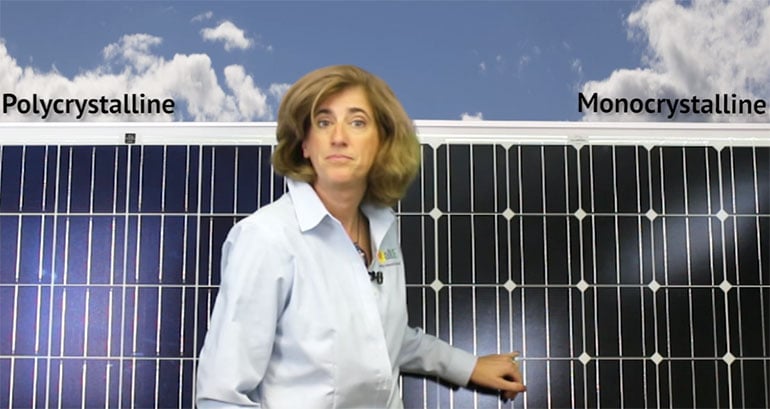
We are often asked what the difference is between monocrystalline and polycrystalline solar panels.
Monocrystalline Solar Panels
A couple of things stand out right away with their appearance. This is due to how solar cells are made. The monocrystalline solar panel is a consistent black or very dark blue color. It is cut into wafers with diamond covered wire from a conical silicon ingot, grown in a lab. To make the ingot, the silicon rocks are melted at 2,500 degrees Fahrenheit, a seed crystal is lowered into the melted slush, and slowly pulled up while rotating. It’s almost like making a hand dipped candle, but instead of melting wax, you are melting rocks.
Due to the cone shape, there is a lot of material wasted as they cut it into the required square shape. That’s why they usually have rounded corners, to help minimize waste. If you look at older solar panels, they actually made them with round cells.
Polycrystalline Solar Panels
Polycrystalline cells are made a different way. They load about 1,300 pounds of silicon rocks into a 3 foot by 3 foot quartz mold to create the square shape needed. It takes 20 hours to melt, and about 3 days to cool down.
The polycrystalline solar panel has a mottled look, like a piece of particle board, it looks like it is made up of multiple pieces of silicon pressed together. That is actually caused from when the melted silicon cools and hardens, it crystallizes, like frost on a window. When it is cut into the wafers, there is much less wasted material than from the conical mono ingot, and is a less expensive manufacturing process.
Cost and Performance Differences
Price
Due to the higher cost of the manufacturing process, monocrystalline solar panels tend to be a little more expensive than polycrystalline panels, although advancements in manufacturing processes are reducing the cost difference.
OK, so monocrystalline panels look different and cost a little bit more than polycrystalline. But the big question is, is it worth the extra cost? To help answer that, let’s talk about performance differences.
Efficiency
Monocrystalline solar panels tend to be more efficient than polycrystalline solar panels. Let’s say, on average, about 17.5% vs.15.5% module efficiency. So they are 2% more efficient. What does that really mean? It means that you can have slightly more power in the same amount of space with monocrystalline than polycrystalline. If we were to build a system with 20 monocrystalline panels, for 5400 watts, I’d need to use one more for 21 panels to get 5460 watts with the 260 watt polycrystalline panels. That would mean a little bit more racking, and if using microinverters or DC Optimizers, more equipment needed. So, while the cost of polycrystalline solar panels may be less, the overall system cost may be the same for both when taking the extra equipment into account.
Temperature
Another performance difference is how they react to temperature. Monocrystalline panels handle heat and lower light conditions slightly better than polycrystalline. How slight is slight? Comparing the temperature coefficient of the two types shows us that monocrystalline short circuit current drops 0.04% for every degree kelvin over standard test conditions. So, if it is 20 degrees hotter on the roof than in the test suite, which is highly likely in the summer, the monocrystalline solar panel can lose .06 amps out of 8 amps. For polycrystalline, it loses 0.051%. That equals losing .08 amps. So, the difference is two one-hundredths of an amp.
In extreme desert conditions, the difference may be big enough to make a difference, but for most residential environments, the difference is quite small.
Shading
Finally, monocrystalline panels tend to behave a little better in less than perfect light conditions. No solar panel, regardless of their type, performs well in the shade. Period. However, if you have slight shading issues, or tend to have hazy skies, monocrystalline panels may typically perform a little better.

Dear Amy and all altE Team,
This is the best place to find true good tutorials with wonderful practical demonstrations for all issues related to PV energy.
I just have one question regarding the solar panels: we can see that for the same number of cells and same dimensions we can have several power ratings, for example 200 Wp, 210 Wp, 250 Wp…
What really controls the nominal power of a PV panel? if the voltage is related to the technology, is it something related to some material density or something in the manufacturing process that changes the current generation?
Thank you in advance for your interest.
Elias Sarif
Excellent question. As the manufacturing techniques get better, they are able to make more efficient cells. The higher he efficiency, the higher the wattage. So panels that last year were 275 watts are now seeing some at 300 in the same size. It’s very exciting.